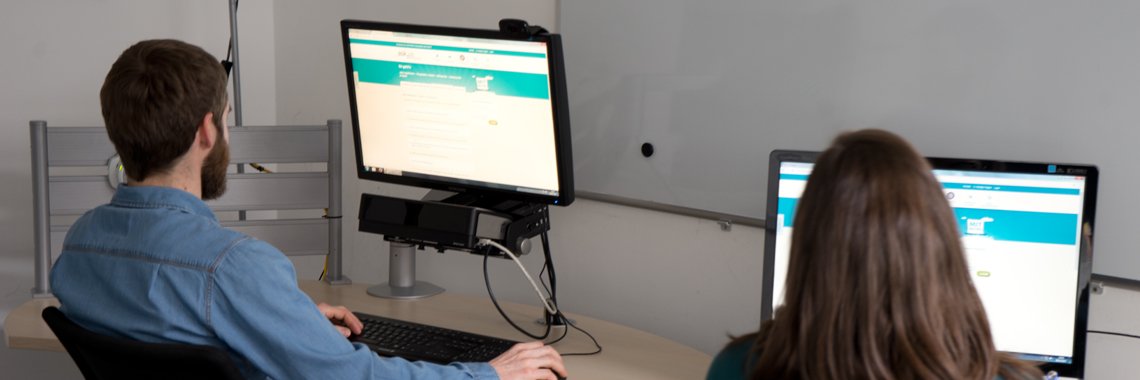
Eye Tracking Studies
Eye Tracking for Usability & Experience Studies
Find out what your users see – Eye Tracking is an established scientific method to spot focus points by following eye movement. While the testpersons fullfil the given tasks, these eye movements are being recorded and are then being anaylised by usability experts.
What can be tested?
The objective of Eye Tracking is to measure in which order and accordingly how long certain points are being observed, where the focus of most users is directed to and how often, respectively in which order the view of the users moves around. This is illustrated via so called heat maps (graphical display of points of interest) and gaze plots. Depending on planning and goals of Eye Tracking studies, is this method applicable in science as well as in market research.
Contents on screens, like websites, user interfaces of software applications, posters, projections or even storage racks or whole shops can be analysed this way. Since there is the possibility of stationary as well as mobile Eye Tracking, it doesn’t even have to be done in a lab.
Possible Questions
- Which points draw the interes of the customer/user?
- What parts of the website, application or poster are being overlooked?
- Are the users being navigated optimally through the structure of a site?
- Which product on the shelf draws attention at first sight/not at all?
- Do customers find their way with the guidance system in the shop easily?
- Are signposts being noticed?
Methodology and approach
There is stationary Eye Tracking and mobile Eye Tracking. Stationary Eye Tracking uses the eye tracker, which records the user’s eye movements, in a lab or on your computer in the office. Mobile Eye Tracking is a system the user wears on his head and so the movements of the eyes are being tracked. The analysis delivers in both situations the mentioned heat maps and gaze plots.
Fixed Eye Tracking
Stationary Eye Tracking uses a fixed eye tracker. It can be fixed on the screen itself, it can stand in a room or it can even be fixed on a mobile device (like a tablet or a smartphone). Thanks to modern technology, the natural mobility is still given and the testperson can move – within a predefined frame (“Head Box”) – freely forward, backward or to the sides. This system is used for testing of applications, e-commerce portals, websystems or for advertising material, etc…
To get to know our system better, have a look at the video below by our partner Tobii.
Eye Tracking and Usability Testing (English, 4:07 minutes)
(Source: Tobii You Tube Channel)
Mobile Eye Tracking
The advantage of mobile Eye Tracking is that it can be used outside of the lab, like in a shopping streets, at the airport, in shops or even the car. The testperson wears the Eye Tracking system, which may look like a cyclist helmet or big glasses, in his head. The device then records all eye movements of the user.
The records of the users can then be analysed and provide heat maps and gaze plots, just like the stationary Eye Tracking.
To get to know this system better, have look at the videos below by our partner Tobii.
Eye Tracking on point of sale analysis (no sound, 2:01 minutes)
(Source: Tobii You Tube Channel)
Presentation of the mobile Eye Tracking system (English, 3:05 minutes)
(Source: Tobii You Tube Channel)
Included services
The followinig services are included in our studies:
- Joint definition of the goal
- Project planning
- Recruitment of the testpersons considering your target groups
- Excecution of the tests
- Analysis of the results
- Report of the study in detail, answering the questions, identification and description of the User Experience problems includind severeness ranking (categorising problems in severity) as well as concrete suggestions for improvement and solution finding
Optional amendments and combinations
To gather optimal results from an Eye Tracking study, we recommend – regarding purpose and field of application – to combine this study with one of the following services:
- User Experience Test
Which experiences does your customer gain with your company/enterprise/product? What do they like most and where do they see optimisation potential? - Usability Test
Where exactly are the Usability problems of your system, your website, your shop? - Depth Interviews
Get to know more about the emotions and experiences of your users with depth interviews. Which were the reasons for User Experience problems? - User Workshops
Let your customers/users discuss! Which solutions do they suggest? What are their wishes and needs?